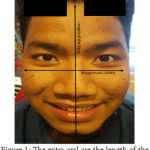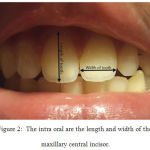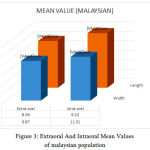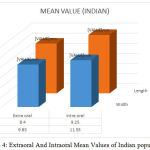Manuscript accepted on :March 03, 2017
Published online on: --
Plagiarism Check: Yes
Nurazman Bin Abdul Salim, Ashish R. Jain and Acu.Varma
Department of Prosthodontics, Saveetha Dental College and Hospitals, Saveetha University, Chennai, India.
Corresponding Author E-mail: dr.ashishjain_r@yahoo.com
DOI : https://dx.doi.org/10.13005/bpj/1197
Abstract
H.Pound’s formula is one of the methods of measurement to determine the size of maxillary central incisor. Pound derived two formulae to determine the width and length of central incisor using bizygomatic width and the length of the face respectively. The aim of this study is to find out reliability of H. Pounds formula for anterior teeth selection in Indian population This study includes sample size 0f (n=100) subjects, of which 50 subjects is Malaysian population and the another 50 subjects is Indian population. The width of the maxillary central incisor is by dividing the bizygomatic width by 16. The length of the maxillary central incisor is by dividing the length of the face by 16. The bizygomatic width is measured from the prominent point of the cheekbone of each side of the face. While the length of the face is measure from the middle of the hairline until the tip of the chin. The vernier calliper will be use. From the data, we could observe that generally, the Indian population’s anterior teeth is larger than the Malaysian population’s anterior teeth. The difference between intra oral and extra oral measurement is the goal of the measurement. From the table, the difference in width between Malaysian and Indian is 0.87mm and 0.85mm respectively. While the difference in length between Malaysian and Indian is 1.64mm and 1.70mm respectively. In conclusion, the H.Pound’s formula give a very slight variation between the extra oral mean value and the intra oral mean value. However, the variation is not very much by the most of 1.70mm variation. Therefore, the H.Pound’s formula is reliable.
Keywords
Anterior teeth; Complete Denture; H.Pounds; Reliability
Download this article as:| Copy the following to cite this article: Salim N. B. A, Jain A. R, Varma A. Reliability of H. Pound’s Formula for Anterior Teeth Selection. Biomed Pharmacol J 2017;10(2). |
| Copy the following to cite this URL: Salim N. B. A, Jain A. R, Varma A. Reliability of H. Pound’s Formula for Anterior Teeth Selection. Biomed Pharmacol J 2017;10(2). Available from: http://biomedpharmajournal.org/?p=14651 |
Introduction
‘OHRQoL’ is an abbreviation for ‘oral health-related quality of life’. OHRQoL is a quite new concept that been emerged few decades ago. This concept plays an important role for the clinical practice of dentistry and dental research.1 OHRQoL is a multidimensional construct that includes the subjective evaluation of the individual’s oral health, functional well-being, emotional well-being, expectations and satisfaction with care and sense of health.2 OHRQoL has a wide range of applications in many studies. It is also a part of general health and well-being, even the World Health Organisation recognised OHRQoL as an important part of the Global Oral Health Program.3 This prove that dental aesthetics are very important despite the fact that the oral health plays a very important role in our health.
In following OHRQoL, the appearance of the teeth is very important. Even though OHRQoL’s recent emergence over the past few decades, it has major implications for the clinical practice of dentistry and dental research.4 This include the aesthetics aspects of the teeth. We all know that oral health plays a very important role in our health. But the dental aesthetics have a very important role in our mental health.5 People would not feel very comfortable showing themselves to the crowd while having poor dental aesthetics. They feel bad for themselves and have low esteem.6 Various studies been made and prove that the patient having higher self-confidence and improved body image and appearance.7 Studies also showed that individuals that are satisfied with their own physical appearance tend to be more successful in social contact.8
The need of dental aesthetics is in high demand nowadays. People always define a beautiful smile with a well-arranged, white pearl-like colour front teeth accompanied with a perfect red lips. This definition along with continuous advertisements from various toothpaste companies had developed the urge among people to have that kind of teeth9,10,11 [NOTE:Fournier, S. (1998). Consumers and their brands: Developing relationship theory in consumer research. Journal of consumer research, 24(4), 343-373.][NOTE:Fournier, S. (1998). Consumers and their brands: Developing relationship theory in consumer research. Journal of consumer research, 24(4), 343-373.][NOTE:Fournier, S. (1998). Consumers and their brands: Developing relationship theory in consumer research. Journal of consumer research, 24(4), 343-373.]. The front teeth are the first thing people see when we talk.12 Therefore, their appearance is very important. For dental operators, the selection of anterior teeth is very important as the size, colour and form of the anterior teeth are the aspects that need to be considered for the anterior teeth selection, especially for the complete denture patient.13 The wrong selection could lead to ‘awkward’ appearance of the teeth. Many formulae been formulated for anterior teeth selection and one them is H.Pound’s formula.14 The aim of this study is to find the reliability of H.Pound’s formula for anterior teeth selection.
Materials and Method
A numerable amount of people were randomly selected for the purpose of this study whose age group arebetween 14 and 62. A letter of consent was given to each participants for their acknowledgement of this study since the measurement of the width and length of their maxillary central incisor is needed, therefore they have to open their mouth. The measurement of the bizygomatic width (furthest distance between two most prominent points of cheek bone)and the length of the faceare also needed. This precaution step was taken to avoid any uneasiness of the participants because maybe some of them are not very comfortable with someone measuring their tooth. A total of 100 participants, in which 50 from Malaysian and the other 50 from India were participated in this study. The measurements were taken by using a vernier calliper. The measurements were divided into extra oral and intra oral. The extra oral are the length of the face and the bizygomatic width (Figure 1). The intra oral are the length and width of the maxillary central incisor (Figure 2). By using H.Pound’s formula, the size of the maxillary central incisor tooth can be determined:

 |
Figure 1: The extra oral are the length of the face and the bizygomatic width. |
 |
Figure 2: The intra oral are the length and width of the maxillary central incisor. |
Results
A total 0f 100 participants were participated in this study in which 50 are Malaysians and another 50 are Indians. The mean value are divided into extra oral and intra oral for easy identification. The extra oral mean value and intra oral mean value are further divided into width and length. For Malaysians, the mean value for extra oral width is 8.36mm and the length is 9.87mm. While for intra oral, the width is 9.23mm and the length is 11.51mm (Figure 3).For Indians, the mean value for extra oral width is 8.40mm and the length is 9.83mm. While for intra oral, the width is 9.25mm and the length is 11.53mm (Figure 4). Since this study is about the reliability of this formula, therefore the difference between the extra oral measurement and the intra oral measurement need to be known. The difference of intra oral and extra oral measurement for Malaysians is 0.87mm for width and 1.64mm for the length (Table 1). While for Indians is 0.85mm for width and 1.70mm for length (Table 2).
 |
Figure 3: Extraoral And Intraoral Mean Values of malaysian population
|
 |
Figure 4: Extraoral And Intraoral Mean Values of Indian population
|
Table 1: Anterior teeth width and length determination in Malaysian population
| Difference of Intra Oral and Extra Oral (Malaysian) | |
| Width | Length |
| 9.23mm –8.36mm = 0.87mm | 11.51mm – 9.87mm = 1.64mm |
Table 2: Anterior teeth width and length determination in Indian population
| Difference of Intra Oral and Extra Oral (Indian) | |
| Width | Length |
| 9.25mm – 8.40mm = 0.85mm | 11.53mm – 9.83mm = 1.70mm |
Discussion
Dental aesthetics give people the perfect smile they ever wanted and many celebrities have been consulted their dentists to get that.15 The front teeth, as always been described by non-dental students, is very important in facial attractiveness. Therefore, for dentists, it is their job to give the patients what they want. The selection of anterior teeth, especially for complete denture patient is very important as the wrong selection of teeth for them will leave an awkward appearance.16,17 Many formulae been formulated for the selection of anterior teeth and one of them is the H.Pound’s formulae. The purpose of this study is to find whether this formula is reliable for the selection of anterior teeth based on the size alone. As described in the data above, the length of width and length of theactual teeth is slightly shorter than what the formulae had given and the most difference between the measurement of the actual length and the formulated length is only 1.70mm. This difference might not make a big difference in the paper, but for the wearer, it might be a big difference.18 However, the different in length of the maxillary central incisor by few millimetres might not be a much of trouble for the patient.19 The selection of participants is not very open. In this study, the participants with crowding is humbly discarded as later the measurements of the teeth would show a big different from the formulated one. Besides, the participants with partially erupted maxillary central incisor is also discarded as for the same reason, if any, but in this study no participants with that condition were discovered.
Conclusion
The selection of anterior teeth for the complete denture prosthesis is very confusing. There is very least data regarding the aesthetics factor that are reliable to be used as an aid for artificial tooth selection. However, the selection of maxillary central incisor by H.Pound’s formulae might find it useful as only a slight difference between the actual lengths of the tooth and the formulated one, which is only 1.70mm. Therefore, H.Pound’s formula are proven reliable.
References
- Gherunpong S., Sheiham A & Tsakos G. A sociodental approach to assessing children’s oral health needs: integrating an oral health-related quality of life (OHRQoL) measure into oral health service planning. Bulletin of the World Health Organization. 2006;84(1):36-42.
CrossRef - Skaret E., Astrom A. N & Haugejorden O. Oral Health Related Quality of Life (OHRQoL) review of existing instruments and suggestions for use in oral health outcome research in Europe. European Global Health Indicators Development Project. Quintessence, Paris. 2004;99-110.
- Gherunpong S., Tsakos G & Sheiham A. Developing and evaluating an oral health-related quality of life index for children; the CHILD-OIDP. Community dental health. 2004;21(2):161-169.
- Sischo L & Broder H. L. Oral health-related quality of life: what, why, how and future implications. Journal of dental research. 2011;90(11):1264-1270.
CrossRef - Ahmad I. Anterior dental aesthetics: Dental perspective. British dental journal. 199;(3):135-141.
CrossRef - Khan M & Fida M. Assessment of psychosocial impact of dental aesthetics. Journal of the College of Physicians and Surgeons Pakistan. 2008;18(9):559.
- Kiyak H. A. Body image issues in dental medicine. In: Cash T. F (ed.) Body image: a handbook of theory, research and clinical practice. Guilford, New York. 2002;342–350.
- Cash T. F., Fleming E. C. Body image issues and social relations. In: Cash T F (ed.) Body image: a handbook of theory, research, and clinical practice. Guilford, New York .2002;277–286.
- Holmes A. The subjective need and demand for orthodontic treatment. British Journal of Orthodontics. 1992;19(4):287-297.
CrossRef - Kershaw S., Newton J. T & Williams D. M. The influence of tooth colour on the perceptions of personal characteristics among female dental patients comparisons of unmodified, decayed and’whitened’teeth. British dental journal. 2008;204(5):E9-E9.
CrossRef - Fournier S. Consumers and their brands: Developing relationship theory in consumer research. Journal of consumer research. 1998;24(4):343-373.
CrossRef - Yalom I. D. The gift of therapy. Piatkus. 2010.
- Tjan A. H., Miller G. D & The J. G. Some esthetic factors in a smile. The Journal of prosthetic dentistry. 1984;51(1):24-28.
CrossRef - Sellen P. N., Jagger D. C & Harrison A. Methods used to select artificial anterior teeth for the edentulous patient: a historical overview. International Journal of Prosthodontics. 1999;12(1).
- Hofel L., Lange M & Jacobsen T. Beauty and the teeth: perception of tooth color and its influence on the overall judgment of facial attractiveness. International Journal of Periodontics and Restorative Dentistry. 2007;27(4):349.
- Cigrand B. J. The rise, fall and revival of dental prosthesis: Introductory lecture. Severinghaus & Beilfuss, printers. 1892.
- Frush J. P., Fisher D. R. Introduction to dentogenic restorations. J Prosthet Dent. 1955;5:586–95.
CrossRef - Wetherell J. D & Smales R. J. Partial denture failures: a long-term clinical survey. Journal of Dentistry. 1980;8(4):333-340.
CrossRef - Snow S. R. Esthetic smile analysis of maxillary anterior tooth width the golden percentage. Journal of Esthetic and Restorative Dentistry. 1999;11(4):177-184.
CrossRef







